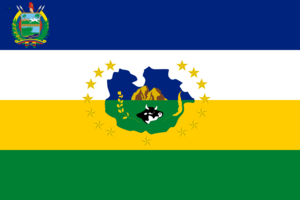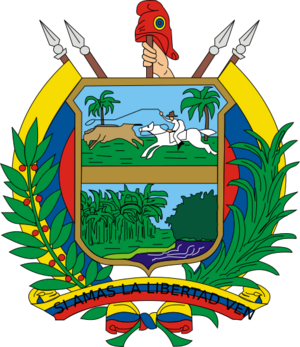Guárico facts for kids
Guárico is one of the 23 states that make up Venezuela. It is located in the central part of the country, known for its wide-open plains called the Llanos. The capital city of Guárico is San Juan de Los Morros. This state is famous for its beautiful natural landscapes and its strong connection to Venezuelan cowboy culture.
Contents
About Guárico
Guárico is a large state in Venezuela. It is often called the "heart of the Llanos" because of its vast plains. These plains are very important for farming and raising cattle. The state's name, Guárico, comes from the Guárico River, which flows through the region.
Geography of Guárico
Guárico's landscape is mostly flat, with large grasslands stretching as far as the eye can see. This area is part of the Llanos, a huge tropical grassland ecosystem. While mostly flat, there are some small mountains and hills, especially in the northern part of the state. These include the "Morros de San Juan," which are unique rock formations.
Many rivers cross Guárico, like the Guárico River, Apure River, and Portuguesa River. These rivers are vital for irrigation and support the local wildlife. The flat terrain and rivers make the land very fertile for agriculture.
Climate in Guárico
The climate in Guárico is tropical, meaning it is generally hot all year round. There are two main seasons: a rainy season and a dry season. The rainy season usually lasts from May to November, bringing lots of water to the plains. The dry season, from December to April, is much hotter and drier. This climate is perfect for the state's agricultural activities.
History of Guárico
The history of Guárico is closely linked to the history of Venezuela itself. Before the arrival of Europeans, indigenous groups lived in the area. During the colonial period, the region became important for cattle ranching.
Guárico played a significant role in Venezuela's fight for independence. Many important battles took place on its plains. Over time, the region developed into the state we know today, officially becoming a state in 1900. Its past is full of stories of brave cowboys and historical events.
Economy and Activities
The economy of Guárico is mainly based on agriculture and cattle ranching. The vast plains are ideal for raising cows, which produce meat and milk. Farmers also grow many crops, including rice, corn, and cotton. These products are important for feeding Venezuela.
Besides farming, there is some oil and gas production in the state. Tourism is also growing, with visitors coming to see the natural beauty of the Llanos, experience cowboy life, and enjoy the local culture.
Culture and Traditions
Guárico has a rich and vibrant culture, deeply rooted in the traditions of the Llanos.
Llanera Music
One of the most famous cultural expressions is Llanera music. This music is played with instruments like the harp, cuatro (a small four-stringed guitar), and maracas. The songs often tell stories about cowboy life, love, and the beauty of the plains. It is a very lively and rhythmic style of music.
Traditional Food
The food in Guárico is hearty and delicious. Popular dishes include pabellón criollo, which is Venezuela's national dish, and carne en vara, which is meat cooked on a stick over an open fire. Other local specialties include cachapas (corn pancakes) and various types of cheese made from cow's milk.
Festivals and Celebrations
People in Guárico love to celebrate. Many festivals are held throughout the year, often related to religious holidays or agricultural cycles. Toros Coleados is a popular traditional sport where cowboys on horseback try to grab a bull by the tail and bring it down. It's a thrilling display of skill and horsemanship.
Wildlife of Guárico
Guárico is home to a wide variety of animals and plants. The Llanos ecosystem supports many unique species.
Animals and Their Life Cycle
You can find many interesting animals here, such as capybaras (the world's largest rodents), deer, and various types of birds. Rivers are full of fish, and you might even spot caimans or anacondas. The wildlife adapts to the wet and dry seasons, with many animals migrating or changing their behavior depending on the water levels. Birds, for example, often have their reproduction cycles during the rainy season when food is plentiful.
Plants and Vegetation
The vegetation in Guárico is dominated by grasslands, but there are also areas with palm trees and gallery forests along the rivers. These forests provide shade and habitat for many animals. Common trees include the samán and jabillo. The plants here are well-adapted to the hot climate and seasonal flooding.
Important Places to Visit
Guárico offers several interesting places for young explorers:
- San Juan de Los Morros: The capital city, known for its unique rock formations called "Los Morros." You can see a large monument to St. John the Baptist here.
- Esteros de Camaguán: A wildlife reserve where you can see many birds, capybaras, and other animals in their natural habitat. It's a great place for nature lovers.
- Guatopo National Park: Although mostly in Miranda state, a part of this beautiful park extends into Guárico, offering lush forests and diverse wildlife.
- Hato La Fe: A typical Venezuelan ranch in the Llanos, where you can experience the cowboy lifestyle and see cattle ranching up close.
Guárico is a fascinating state that offers a glimpse into the heart of Venezuela's plains, its rich culture, and its amazing natural beauty.
Images for kids
-
Hato La Fe, Calabozo, Llanos of the Guárico state.
See also
 In Spanish: Estado Guárico para niños
In Spanish: Estado Guárico para niños

















